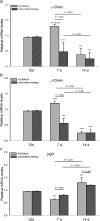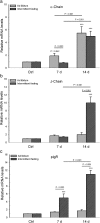Intermittent fasting favored the resolution of Salmonella typhimurium infection in middle-aged BALB/c mice
- PMID: 26798034
- PMCID: PMC5005893
- DOI: 10.1007/s11357-016-9876-3
Intermittent fasting favored the resolution of Salmonella typhimurium infection in middle-aged BALB/c mice
Abstract
Intermittent fasting (IF) reportedly increases resistance and intestinal IgA response to Salmonella typhimurium infection in mature mice. The aim of this study was to explore the effect of aging on the aforementioned improved immune response found with IF. Middle-aged male BALB/c mice were submitted to IF or ad libitum (AL) feeding for 40 weeks and then orally infected with S. typhimurium. Thereafter, infected animals were all fed AL (to maximize their viability) until sacrifice on day 7 or 14 post-infection. We evaluated body weight, bacterial load (in feces, Peyer's patches, spleen and liver), total and specific intestinal IgA, lamina propria IgA+ plasma cells, plasma corticosterone, and messenger RNA (mRNA) expression of α-chain, J-chain, and the polymeric immunoglobulin receptor (pIgR) in liver and intestinal mucosa. In comparison with the infected AL counterpart, the infected IF group (long-term IF followed by post-infection AL feeding) generally had lower intestinal and systemic bacterial loads as well as higher total IgA on both post-infection days. Both infected groups showed no differences in corticosterone levels, body weight, or food and caloric intake. The increase in intestinal IgA was associated with enhanced pIgR mRNA expression in the intestine (day 7) and liver. Thus, to maintain body weight and caloric intake, IF elicited metabolic signals that possibly induced the increased hepatic and intestinal pIgR mRNA expression found. The increase in IgA probably resulted from intestinal IgA transcytosis via pIgR. This IgA response along with phagocyte-induced killing of bacteria in systemic organs (not measured) may explain the resolution of the S. typhimurium infection.
Keywords: Intermittent fasting; Intestinal IgA; Liver polymeric immunoglobulin receptor; Middle-aged mice; Salmonella typhimurium infection.
Figures






Similar articles
-
Intermittent fasting promotes bacterial clearance and intestinal IgA production in Salmonella typhimurium-infected mice.Scand J Immunol. 2014 May;79(5):315-24. doi: 10.1111/sji.12163. Scand J Immunol. 2014. PMID: 24612255
-
Protective Effect of Moderate Exercise for BALB/c Mice with Salmonella Typhimurium Infection.Int J Sports Med. 2016 Jan;37(1):63-70. doi: 10.1055/s-0035-1559697. Epub 2015 Nov 3. Int J Sports Med. 2016. PMID: 26528943
-
Lactoferrin increases both resistance to Salmonella typhimurium infection and the production of antibodies in mice.Immunol Lett. 2010 Nov 30;134(1):35-46. doi: 10.1016/j.imlet.2010.08.007. Epub 2010 Aug 18. Immunol Lett. 2010. PMID: 20727369
-
Secretory autophagy holds the key to lysozyme secretion during bacterial infection of the intestine.Autophagy. 2018;14(3):365-367. doi: 10.1080/15548627.2017.1401425. Epub 2018 Jan 29. Autophagy. 2018. PMID: 29157080 Free PMC article. Review.
-
Effects of Intermittent Fasting on Health, Aging, and Disease.N Engl J Med. 2019 Dec 26;381(26):2541-2551. doi: 10.1056/NEJMra1905136. N Engl J Med. 2019. PMID: 31881139 Review. No abstract available.
Cited by
-
Changes in human gut microbiota composition are linked to the energy metabolic switch during 10 d of Buchinger fasting.J Nutr Sci. 2019 Nov 12;8:e36. doi: 10.1017/jns.2019.33. eCollection 2019. J Nutr Sci. 2019. PMID: 31798864 Free PMC article.
-
Calorie restriction in rodents: Caveats to consider.Ageing Res Rev. 2017 Oct;39:15-28. doi: 10.1016/j.arr.2017.05.008. Epub 2017 Jun 10. Ageing Res Rev. 2017. PMID: 28610949 Free PMC article. Review.
-
Ramadan intermittent fasting and immunity: An important topic in the era of COVID-19.Ann Thorac Med. 2020 Jul-Sep;15(3):125-133. doi: 10.4103/atm.ATM_151_20. Epub 2020 Jun 18. Ann Thorac Med. 2020. PMID: 32831933 Free PMC article. Review.
References
MeSH terms
Substances
LinkOut - more resources
Full Text Sources
Other Literature Sources
Medical
Miscellaneous
